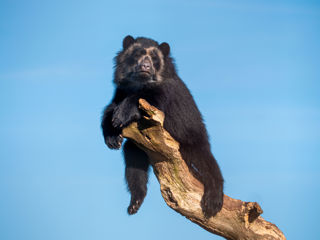
Spectacled bear
Scientific name: Tremarctos ornatus
The spectacled (or Andean) bear is the only bear species that is native to South America. They are agile climbers and are known for their ability to build nests high up in trees.
The spectacled bear’s fur is predominately black or dark brown. The male bears are larger than the females and can weigh up to 175kg. Female spectacled bears can weigh up to 80kg.
Spectacled bears are native to the mountainous regions of South America and have been found at altitudes of up to 4,750 meters. However, they are very hardy creatures and are renowned for being highly adaptable to any habitat.
The spectacled bear faces many threats including hunting, human-wildlife conflict and habitat destruction. Sadly, the number of spectacled bears in the wild has dropped significantly in recent years.

-
At Noah's Ark...
We have 4 Spectacled bears... Rasu, Madidi, Beni and Tuichi.
-
We live...
Between the Lion enclosure and the Rhea enclosure.
-
Size Fact
Male bears can grow to 2 meters in length (from head to tail).
-
Food Fact
Spectacled bears are omnivores. They mostly eat vegetation but do also eat insects, birds and carrion. They occasionally eat livestock too.
-
Fun Fact
They are known as ‘spectacled’ bears due to the white circles of fur that occur around their eyes

Adopt Me
You can support our conservation efforts and help with the costs of keeping rare and wonderful zoo animals by adopting a Bear. Adopt a Bear for yourself or as a gift.
You might also like...
-
![Meerkats]()
Meerkat Keeper Talk
Come along and learn about our mob of Meerkats from our experienced animal keepers.
Find out more
-
![Zoe And Falcon]()
Bird of Prey Flying Display
Watch our majestic birds of prey in our new Wings of Wonder flying display.
Find out more
-
![Andean Bear]()
Bear Keeper Talk
Learn about our Spectacled bears from our experts and find out what it is like to be a Spectacled bear keeper.
Find out more
-
![African Elephant - Shaka 2]()
Elephant Keeper Talk
Did you know Elephants are the largest land animals on Earth? Come and join our Elephant Keepers and learn about our bulls.
Find out more






